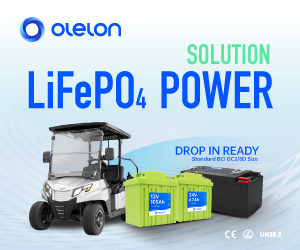According to Fred Wehmeyer, Senior VP of Engineering at U.S. Battery Manufacturing, deep-cycle Absorbed Glass Matt (AGM) batteries could be a better choice than Flooded Lead-Acid (FLA) batteries in some situations. Two of the most common would be where the batteries are hard to get to for watering, or in applications where the higher cost of AGM batteries is offset by the time and overall cost of regular FLA battery maintenance.
From a cost per watt-hour perspective, deep-cycle FLA batteries are a better long-term value if they are given the required regular maintenance. For a golf course with a fleet of vehicles, the time spent performing this kind of maintenance is an added cost. When done correctly, however, it can greatly extend the life of the batteries and lower overall operating costs.
For the individual golf car owner, performing the required regular maintenance can sometimes be difficult, particularly when other family members use the golf car most of the time. If you are an owner who pays to have this service done regularly, the costs of this maintenance can also quickly add up. In some golf cars, accessing all the batteries for maintenance can also be difficult, especially for the elderly who use these vehicles to get around their retirement communities. For these reasons, batteries that do not require regular maintenance can be a significant advantage, and can actually last longer than FLA batteries that are not properly maintained.
This is why some users are willing to pay the extra initial cost of AGM batteries. To be clear, AGM batteries typically cost from 25 to 50 percent more per watt-hour than FLA batteries, so there’s a higher cost upfront. But the benefits of no-maintenance make them a popular choice for many users. AGM batteries are sealed and the electrolyte is absorbed in special glass mat separators that retain all the electrolyte needed for the life of the battery. Since there is no free electrolyte, the oxygen generated on charge is recombined at the negative plate. In normal operation, hydrogen is not generated and no water is lost. This eliminates the need to replace water and also allows the battery to be sealed with a one-way valve, which allows for a small amount of gas release if severely overcharged.
For AGM batteries to charge properly, it is important that a charger designed for use with AGM batteries is used. In newer chargers, this may be as simple as changing the charge algorithm to the recommended AGM charge algorithm for the batteries being used. Some older chargers designed for use with FLA batteries don’t have the capability for changing charge algorithms and cannot be used with AGM batteries. The use of these chargers with AGM batteries will result in very short battery life and will void the warranty.
Better AGM Designs Coming
Because of their popularity, battery manufacturers are continually improving the design of AGM batteries to increase deep-cycle capacity and cycle life through the use of improved battery designs, raw materials, and additives for deep cycle service. Manufacturers also continue to add more battery sizes and capacity ranges in all the common voltages. This allows AGM batteries to be used in a wider variety of applications that may require a maintenance-free operation, or simply benefit from the convenience of greatly reduced maintenance.
In addition to these benefits, it’s also important to note that AGM batteries are also fully recyclable. This is part of an effort by the lead battery industry that has led to a 99+ percent recycling rate, creating a safe and sustainable energy technology. All lead batteries enjoy true cradle-to-cradle recycling. In other words, 100 percent of the lead used in today’s lead batteries can be used to build new ones. No other battery type can make this claim.
To determine if an AGM battery is best for your particular application, visit your local battery dealer and ask for their advice based on your particular needs and use. Additional information on AGM and FLA batteries for golf car applications can be found on the U.S. Battery Manufacturing website at www.usbattery.com.

























